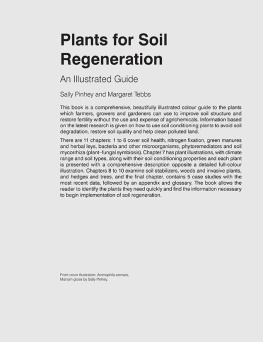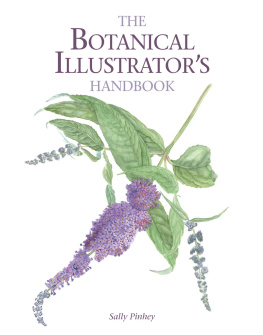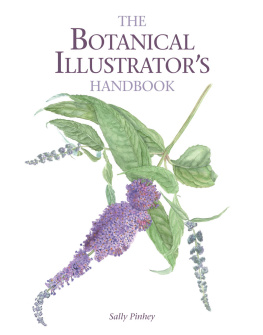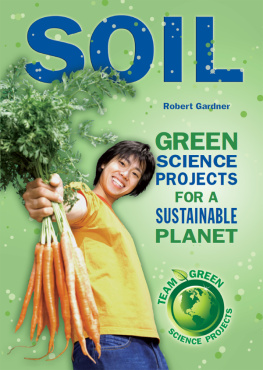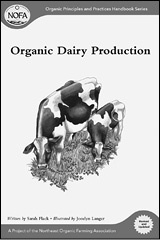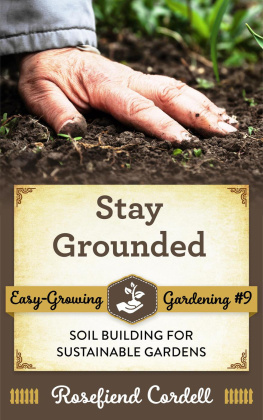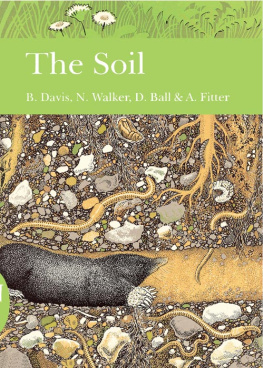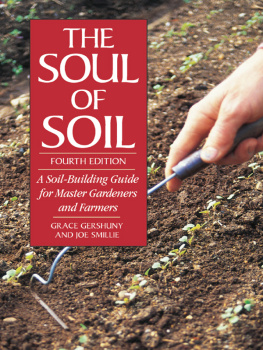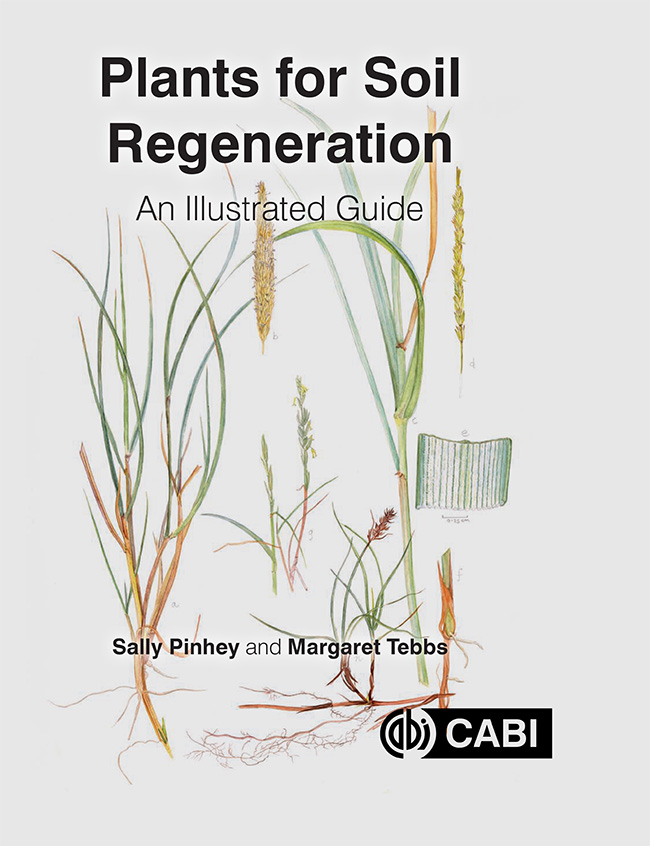
Plants for Soil Regeneration: an Illustrated Guide
Plants for Soil Regeneration: an Illustrated Guide
by
Sally Pinhey and Margaret Tebbs

CABI is a trading name of CAB International
CABI | CABI |
Nosworthy Way | WeWork |
Wallingford | One Lincoln St |
Oxfordshire OX10 8DE | 24th Floor |
UK | Boston, MA 02111 |
USA |
Tel: +44 (0)1491 832111 |
Fax: +44 (0)1491 833508 | Tel: +1 (617)682-9015 |
E-mail: | E-mail: |
Website: www.cabi.org |
Sally Pinhey and Margaret Tebbs 2022. All rights reserved. No part of this publication may be reproduced in any form or by any means, electronically, mechanically, by photocopying, recording or otherwise, without the prior permission of the copyright owners.
A catalogue record for this book is available from the British Library, London, UK.
Library of Congress Cataloging-in-Publication Data
Names: Pinhey, Sally, author. | Tebbs, Margaret Cecilia, author.
Title: Plants for soil regeneration : an illustrated guide / Sally Pinhey, Margaret Tebbs.
Description: Boston, MA, USA : CAB International, [2022] | Includes bibliographical references and index. | Summary: This book gives farmers, growers and gardeners information and a visual guide to the plants which can be used to improve soil quality without the use of agrichemicals-- Provided by publisher.
Identifiers: LCCN 2021057055 (print) | LCCN 2021057056 (ebook) | ISBN 9781789243604 (hardback) | ISBN 9781789243611 (ebook) | ISBN 9781789243628 (epub)
Subjects: LCSH: Soil restoration. | Soil science. | Soil management. | Soils--Quality.
Classification: LCC QH541.5.S6 P56 2022 (print) | LCC QH541.5.S6 (ebook) | DDC 577.5/7--dc23/eng/20211213
LC record available at https://lccn.loc.gov/2021057055
LC ebook record available at https://lccn.loc.gov/2021057056
References to Internet websites (URLs) were accurate at the time of writing.
ISBN-13: 9781789243604 (hardback)
9781789243611 (ePDF)
9781789243628 (ePub)
DOI: 10.1079/9781789243604.0000
Commissioning Editor: Ward Cooper
Editorial Assistant: Emma McCann
Production Editor: James Bishop
Typeset by SPi, Pondicherry, India
Printed and bound in the UK by Severn, Gloucester
Contents
Preface
It is neither fanciful nor an exaggeration to say that plants are the most essential elements of our world. From the earliest appearance of life on earth, they developed their own survival strategies, created soil, shaped atmospheric and soil conditions, and provided both homes and food for animals. We should respect, research and remember the amazing abilities of plants to adapt to adverse conditions, the flip side of which may be to alter soil conditions to both their and our advantage.
Growing food is nothing new. Traditional farming has been handed down through the generations for thousands of years, each generation doing what it believed best. Recent use of agrochemicals promised much in famine relief in the short term but created dangerous imbalances in elemental cycles.
The purpose of this book is to explore some of the ways in which plants may be used to fix or build cultivable earth, restore impoverished soil, maintain soil in good condition and decontaminate polluted soil. Many plants fall into more than one category. While not the apparent quick fix that chemical treatments offer, plant cover is cheaper, safe and natural. Plants do not need to be mined, and do not need vast factories or distribution networks. With a little help and judicious planting, they just get on with doing what they do best.
Of the many types of soil conditioning, we have selected six categories: soil stabilizers, green manures, herbal lays and cover crops, nitrogen fixers and phytoremediators. While reference may be made to tropical plants in common use, the plants illustrated in this book are temperate-climate plants. The list is not exhaustive. Plants are indexed with both their English and botanical names. The pages facing the illustrations address problems and solutions.
Agricultural expertise is a mix of well-known, tried and tested practices, and scientifically proven facts and effects. This book draws on all sources of information. Where something is unproven, the authors recommend it with caution. Many recent academic studies have focused on exploring traditional or folk beliefs and researching the scientific basis for them. This provides valuable information, but unfortunately such research is slow and expensive, and the range of subjects yet to be studied is unlimited. It would be very helpful to know, for instance, why a planting strategy usually works but sometimes does not. There are so many variables in plant and soil interactions that knowledge, care and diligence are the most important tools in using plants to restore damaged soils. This book is part of that movement towards sustainability.
Introduction by Dr Philip Cribb
When I was an undergraduate, the late Rachel Carsons Silent Spring first raised my awareness of the perils of meddling with nature without a full understanding of the consequences. At the time, the insecticide DDT (dichlorodiphenyltrichloroethane) was widely used around the world, particularly in the control of mosquitoes, the vectors of malaria, yellow fever and other debilitating and often fatal diseases. Its deleterious effects on birds and other organisms had passed unnoticed by the chemical companies and politicians who promoted its widespread use. Fortunately, her campaign led to its eventual banning. However, new perils to wildlife continue to emerge, the latest to receive widespread publicity being the catastrophic loss of insects, such as bees and butterflies, where neonicotinoids have been implicated.
Late in 1970, I landed in Peru on my first botanical expedition, calling first at the Lima International Potato Center. The driving force for the institute was the rapidly declining number of cultivated potato varieties being grown by the indigenous people in the Peruvian and Bolivian Andes where monocultures were being encouraged by multinational agrichemical businesses that has expanded into plant breeding. They were giving high-yielding cultivars free to the local farmers who forsook their indigenous varieties (over 2000 named cultivars at the time) with very mixed results. The new clones needed artificial fertilizers and pesticides to thrive, sold to the farmers by the same companies that provided the seed potatoes. In poverty-stricken communities, the lack of sustainability of such practices rapidly became apparent. Local farmers soon realized that the same pests and diseases attacking their new crop would have affected only a small proportion of their traditional crop and they would have been able to harvest enough each year to sustain their family life. Unfortunately, reversion to traditional practices was difficult because the old varieties were, by then, difficult or impossible to acquire. For me, it was an object lesson in how development needs to take into account a wide variety of issues that might not be immediately apparent. The politicians who pushed the groundnut scheme in East Africa in the 1960s also thought that they had backed a winner, despite scientists telling them that their environmental data were insufficient to guarantee success. The scheme failed when drought hit the region again and bankrupted local farmers, who had been led to think that they would gain a sustainable income for years to come.
Next page
